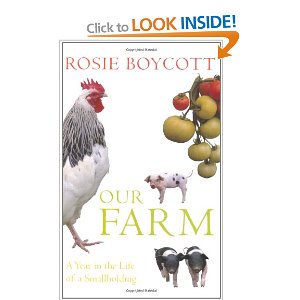When you are out shopping and buy a packet of fresh ham - how 'fresh' is your ham, really?
Well we've been reading former editor of the Daily Express Rosie Boycott's book 'Our Farm' - A Year in the Life of a Smallholding with great interest and here follows an enlightening extract:
 On the kitchen table Colin has laid out papers, labels and packets of Tesco’s ham. He talks me through the process. Hygrade buys pigs at ‘best price’, and if they’re not available at the best price in the UK then they are bought from other EU countries. They’re butchered at Beechings in Chard and then, if there’s an over supply, or if Tesco have suddenly decided they don’t need so much ham that month, the pork is sent to Taunton, where it’s stored and frozen at Novacold. It is sent back to Chard either when there is a shortage of meat or when it’s over ten months old. Under law, the pork from the dead pigs has to reach your shopping basket within a year of the animal’s demise. It is generally the case that what we buy in the supermarkets labelled as ‘fresh meat’ can be anything from thirty-five days to eleven months old.
On the kitchen table Colin has laid out papers, labels and packets of Tesco’s ham. He talks me through the process. Hygrade buys pigs at ‘best price’, and if they’re not available at the best price in the UK then they are bought from other EU countries. They’re butchered at Beechings in Chard and then, if there’s an over supply, or if Tesco have suddenly decided they don’t need so much ham that month, the pork is sent to Taunton, where it’s stored and frozen at Novacold. It is sent back to Chard either when there is a shortage of meat or when it’s over ten months old. Under law, the pork from the dead pigs has to reach your shopping basket within a year of the animal’s demise. It is generally the case that what we buy in the supermarkets labelled as ‘fresh meat’ can be anything from thirty-five days to eleven months old.Colin explains to me what happens in the factory. Once there, the hams are dunked in vast vats which inflate the meat with water, at the same time adding salt, dextrose, stabilisers such as diphosphates, triphosphates and polyphosphates, and the antioxidants sodium ascorbate and the preservative sodium nitrate. The hams are tumbled around in these vats of chemical solution for one hour continuously, then for ten minutes on, fifty minutes off, for another twenty-four hours. The minimum time the meat spends in the stainless steel tumblers is thirty-six hours, the maximum is five days. The resulting hams are cooked to a temperature of 70.5°C for two minutes, then cooled to less than 5 degrees. Then they’re bagged up and can be stored for another twenty-eight days. After that, the hams are taken out of their bags and roasted at 250°C for a minimum of thirty minutes, cooled again, and refrigerated for up to two days. Colin gives me a copy of the internal flow diagram for pre-sliced ham and I notice that at this point on the list of what-to-do-and-when, the ham ceases to be described as ‘meat’ or ‘legs’ and becomes simply ‘product’. The product is then transferred from the fridge to a spiral slicing machine. The hock bone is removed and a cutter whizzes round in endless circles, slicing off pieces of what will be sold as ‘fresh ham’. The product is then vacuum packed and each pack is inflated with preservative gases. The check-list notes that ‘each pack is inspected for seal integrity’.

‘That’s the important bit,’ Colin tells me. ‘Once you break the seal, you may have
only a couple of days left. When you buy ham, you think you’re buying
something fresh; in fact, you’re buying something that is right at the very end of
its usable life.’’
To read more you can buy Rosie's book at Amazon by clicking here
'Our Farm' - A Year in the Life of a Smallholding